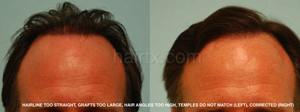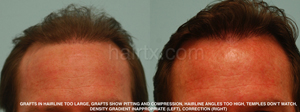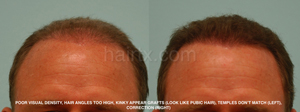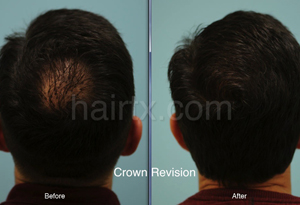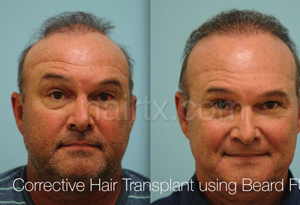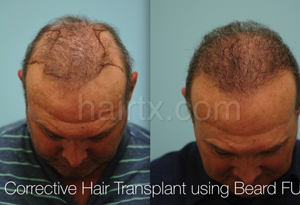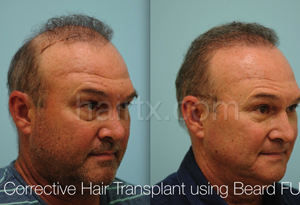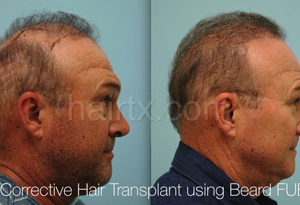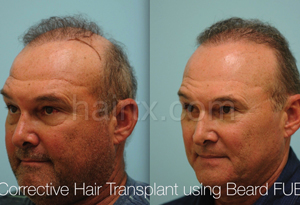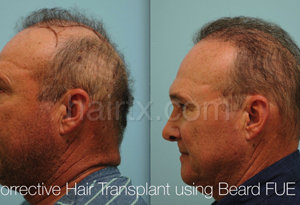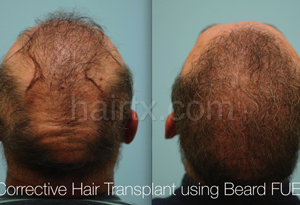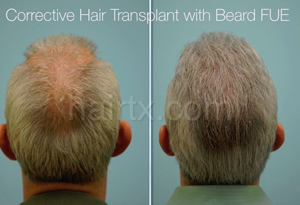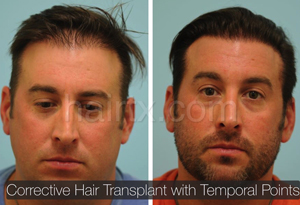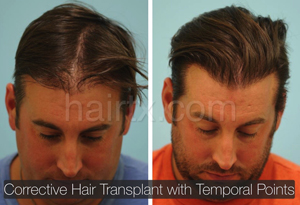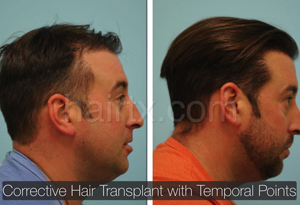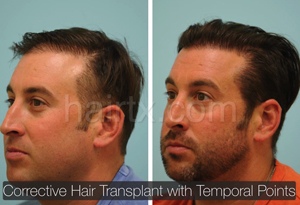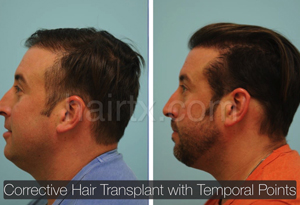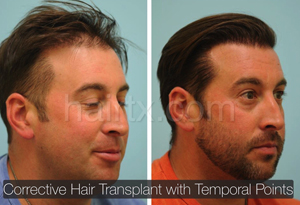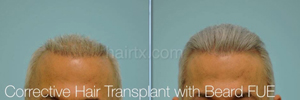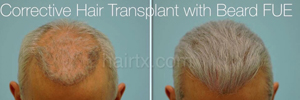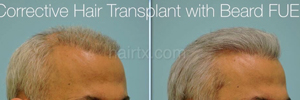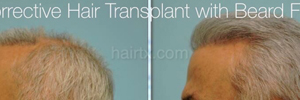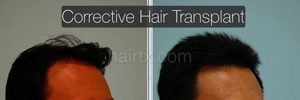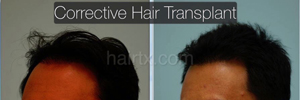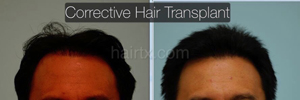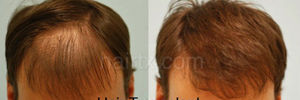Corrective Hair Transplants
A good hair transplant result is undetectable not only to another viewer but to another hair-transplant surgeon. There are many reasons for a hair transplant to look unnatural and require a corrective procedure. Sometimes, it can be due to the use of old technology, the progression of hair loss, or poor technique. For example, large round “plugs”, scalp reductions, and/or flaps were the procedure of choice in the past but with the progression of hair loss, their results became unnatural. Sometimes the transplanted area looks unnatural and sometimes the donor area is left with wide scars and at times unnatural hair patterns that may be difficult to correct. Even though plugs and large reductions may not be performed anymore, the results of hair transplants can still look unnatural.
Contact Us Today! Read Our Manifesto Visit Our Gallery
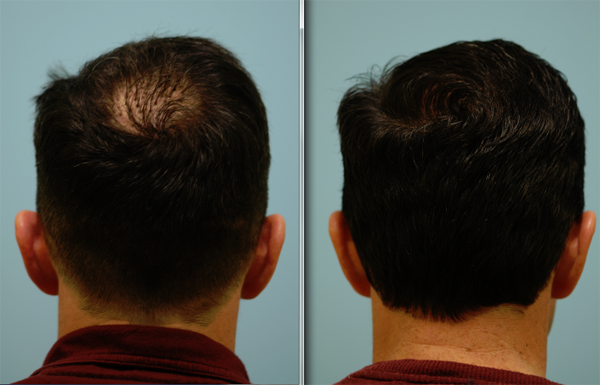
This patient had plugs transplanted into his crown in his late twenties. As his hair loss progressed, the plugs became exposed and made his crown look very unnatural. The photos show him before and after a corrective hair transplant.
If an inexperienced surgeon designs an unnatural hairline shape, the patient will have a result that is unsatisfactory to the eye. If the hairline is not meticulously created in a way that is consistent with a natural hair pattern, it can still look pluggy, too straight, or unnatural for a number of reasons. If the hair-loss pattern does not match one that exists in nature (following the Norwood-Hamilton Scale) and even slightly deviates from this pattern, the result may not look natural to one’s eye but the viewer will not be able to articulate why that is the case.
Finally, if the assistant team does not place the right graft into the right-sized recipient site with the right hair-curl direction at the right depth with minimal manipulation and trauma, the result can be unnatural due to kinkiness, poor growth, hairstyling difficulties, etc.
The first step of a corrective hair transplant is to determine what is wrong and secondly, what can be done to correct the transplant. Sometimes larger plugs or poorly placed grafts can easily be covered in the front with better grafts (a process known as “de-emphasis grafting”) and make the previous result almost entirely invisible. At other times, the grafts simply are poorly positioned in an area where only the naked scalp should be (like in the forehead), and these grafts must be removed and recycled (i.e., placed back elsewhere in the scalp). In many cases, the corrective hair transplant requires extensive judgment and experience, which Dr. Lam has. In addition, Dr. Lam will evaluate the type and extent of aesthetic deformity as well as the donor-hair capacity, and create a very thoughtful creative plan that is the best solution for you. A thorough consultation with Dr. Lam will help you decide what would be the best strategy suited for you. Please visit Dr. Lam’s corrective hair transplant photo gallery to see some examples of his corrective hair transplant results and how he achieved the correction.

This patient is shown with poor density with poor angles of transplanted hair and underwent correction with a higher quality hair transplant procedure.
For those who wear a hairpiece/hair system but would like to look more natural, a hair transplant may be a good solution. Depending on the individual’s donor area and the extent of the baldness, Dr. Lam may recommend one or several hair transplant procedures to help exit the use of the hair system. Alternatively, in an individual who does not have sufficient donor hair to cover the entire balding area, Dr. Lam may recommend keeping the hair system but transplanting only targeted areas, such as the hairline or the temporal points in order to make a hair system appear much more natural.

This patient must wear his hair system down to cover the exposed temple (left image) but after temple hair transplant (right image)his hair system can be styled more naturally and freely.”The temporal point refers to the triangular shape of hair that extends outward, as shown in the illustration from Dr. Lam’s textbook.
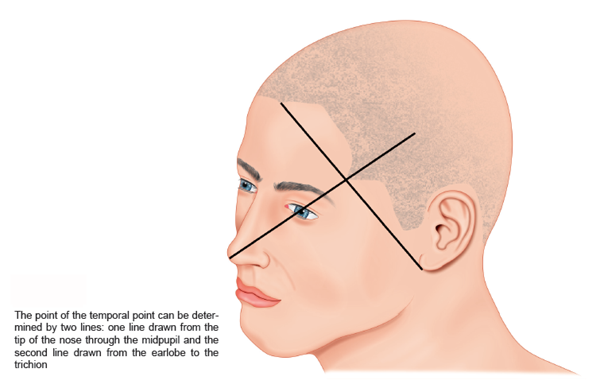
Unfortunately, today Dallas hair transplant surgeon Dr. Sam Lam is performing an increasing number of corrective hair transplant procedures since there are many more individuals who need these services. Using both FUE and FUT along with scalp and beard hairs, he can have the most advanced method or combination of methods to correct your poor prior hair transplant result. He also uses scalp micropigmentation (SMP) with an in-house artist to correct scars and to add density to areas that require this technique to fix the problem at hand. At other times, he also requires surgical excision of problem grafts or scars, or uses any combination of the above methods to achieve a more natural result for you.
How Much Do Corrective Hair Transplants Cost?
Corrective hair transplants must be customized to address the needs of each individual patient in order to achieve the best results. The cost of the treatment depends on the amount of correction required to achieve the desired results. An assessment of the hair will be performed during your consultation to determine the best treatment plan and the associated cost.
Contact Our Office
If you’re interested in learning more about corrective hair transplants in Plano, TX, contact our office to schedule your informative consultation today. Dr. Sam Lam is a highly skilled hair specialist who will help you reclaim confidence in your appearance.
Key Points
- Ideal candidate
- Men who have unnatural results from a hair transplant or flap-rotation procedure
- Women who have unnatural results from a hair transplant or hairline-lowering procedure
- What to do
- Schedule your procedure and plan on one week for recovery during which time you are functional but may not be socially presentable for several days.
- If your plan for restoration includes beard harvesting, avoid shaving for 48 hours prior to the procedure. It is important to keep your beard at a specific length (no longer than 1 to 2 mm or a 2-day growth).
- If you color your hair regularly, you are recommended to color it 2 to 3 days prior to your procedure. You will be allowed to recolor it 2 weeks after the procedure.
- If you are out of town, you will be required to arrive the day before the procedure and will be allowed to travel the day after, staying in town for a total of two nights. However, if you are not in town at two weeks after the procedure, you will need a professional to remove your sutures (stitches) if Dr. Lam performed an FUT procedure. Dr. Lam has many colleagues across the United States and the world who may be able to help remove your sutures so that you do not need to stay in Dallas for two weeks or return in two weeks to have your sutures removed.
- What to expect
- You can wear a hat immediately after the procedure, and you can wash your hair 24 hours after and travel the next day.
- Transplanted hairs should start growing as early as 3 to 4 months post-procedure (but may not have any substantial growth for a few months after that period) and should improve in growth up to 12 months post-procedure or longer.
- Corrective surgeries can be done in stages or your restoration design may include a second procedure. Depending on hair growth and the area that needs to be restored, you may plan your second procedure as early as 6 months afterward and ideally 10 to 12 months after your first procedure.
FAQs
-
What are some of the key elements in ensuring that a hair-transplant result looks natural?
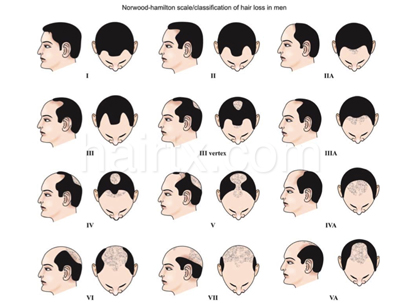 First, the hairline shape and overall design must follow a natural Norwood pattern that exists in nature. It cannot be over emphasized that many surgeons simply do not have enough experience to understand that a Norwood pattern must be replicated or the result will not look correct. Secondly, the hairline must be created in a very soft design that mimics nature. If the angulation of the sites is incorrect, the density gradient does not match nature, and the sites are poorly oriented, the result can be devastating. In addition, the team that assists Dr. Lam headed by Emina Karamanovski Vance must execute perfectly as far as quality control. In the accompanying figures, the compression, pitting, and kinkiness are the fault of the surgical team; whereas the other problems are related to the surgeon. As you can see, it requires an excellent surgeon and team to deliver consistently high-level results. Understanding how hair angles and distribution should be placed depending on the regions of the scalp and the degree of hair loss is a critical element to successful hair transplants that look natural and visually dense.
First, the hairline shape and overall design must follow a natural Norwood pattern that exists in nature. It cannot be over emphasized that many surgeons simply do not have enough experience to understand that a Norwood pattern must be replicated or the result will not look correct. Secondly, the hairline must be created in a very soft design that mimics nature. If the angulation of the sites is incorrect, the density gradient does not match nature, and the sites are poorly oriented, the result can be devastating. In addition, the team that assists Dr. Lam headed by Emina Karamanovski Vance must execute perfectly as far as quality control. In the accompanying figures, the compression, pitting, and kinkiness are the fault of the surgical team; whereas the other problems are related to the surgeon. As you can see, it requires an excellent surgeon and team to deliver consistently high-level results. Understanding how hair angles and distribution should be placed depending on the regions of the scalp and the degree of hair loss is a critical element to successful hair transplants that look natural and visually dense. -
What are some things that I should know about corrective surgery?
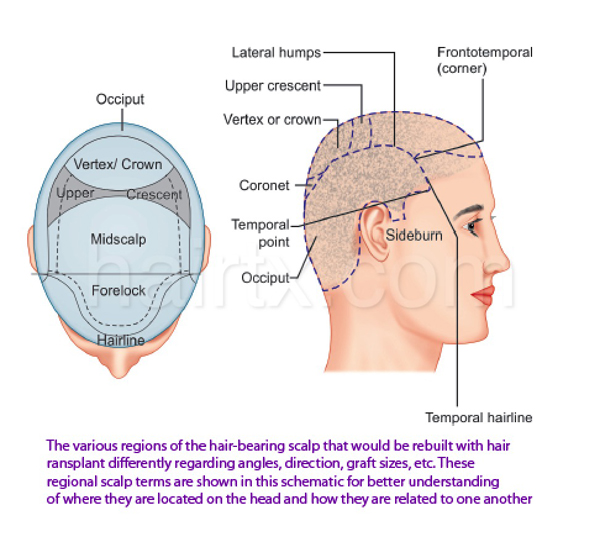 Corrective surgery encompasses the full gamut of aesthetic problems and requires detailed evaluation. The creative process that Dr. Lam undertakes is to identify the problem, how to fix it, and where to get the donor hair to correct the problem. If the hairline is too low, then the only real way to correct this problem is to excise and elevate the hairline to a more natural position. If the hairline is in a relatively good position or too high, Dr. Lam can use finer grafts in front of the bad grafts without having to remove them through a process he calls “de-emphasis grafting”. With sufficient donor hair, many problems can be covered. Without sufficient scalp donor hair, beard/body hair may need to be used. If there are many aesthetic problems that are relatively severe in nature and there is very little donor hair (both scalp and body) left, then Dr. Lam has to use a very creative approach prioritizing the most important problem areas to correct and possibly counsel you on how to use a creative hairstyle and/or scalp micro pigmentation (SMP, or scalp tattoo) to further improve the situation. This complex discussion must be undertaken during a consultation, ideally in person, to uncover the best course of action.
Corrective surgery encompasses the full gamut of aesthetic problems and requires detailed evaluation. The creative process that Dr. Lam undertakes is to identify the problem, how to fix it, and where to get the donor hair to correct the problem. If the hairline is too low, then the only real way to correct this problem is to excise and elevate the hairline to a more natural position. If the hairline is in a relatively good position or too high, Dr. Lam can use finer grafts in front of the bad grafts without having to remove them through a process he calls “de-emphasis grafting”. With sufficient donor hair, many problems can be covered. Without sufficient scalp donor hair, beard/body hair may need to be used. If there are many aesthetic problems that are relatively severe in nature and there is very little donor hair (both scalp and body) left, then Dr. Lam has to use a very creative approach prioritizing the most important problem areas to correct and possibly counsel you on how to use a creative hairstyle and/or scalp micro pigmentation (SMP, or scalp tattoo) to further improve the situation. This complex discussion must be undertaken during a consultation, ideally in person, to uncover the best course of action. -
How does Dr. Lam fix any scars on my scalp or scars that I got from my facelift?The answers to this question can be found in the section “Scar Repair”.
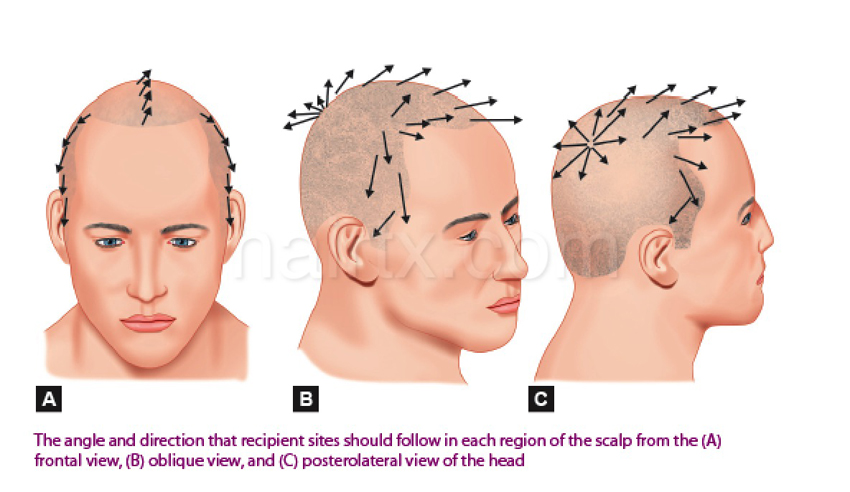
 Lam Institute For Hair Restoration
Lam Institute For Hair RestorationVideos
Photos
For more Corrective Hair Transplants Before & After Photos, Click here
Related Blog Post
Hair Transplant Dallas
When people think of a hair loss they typically think of men, however, many women also experience hair loss. When women experience hair loss, it is often traumatic and hits their self-confidence hard. Many women pride themselves on their hair. Dr. Lam understands the delicate landscape… Read More

